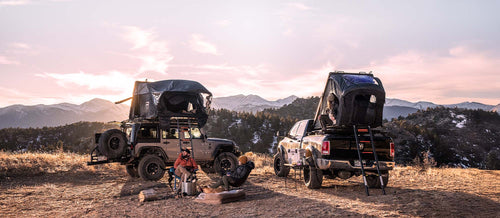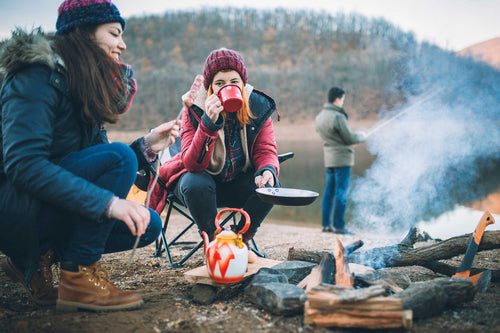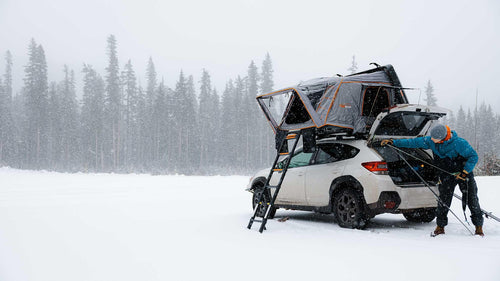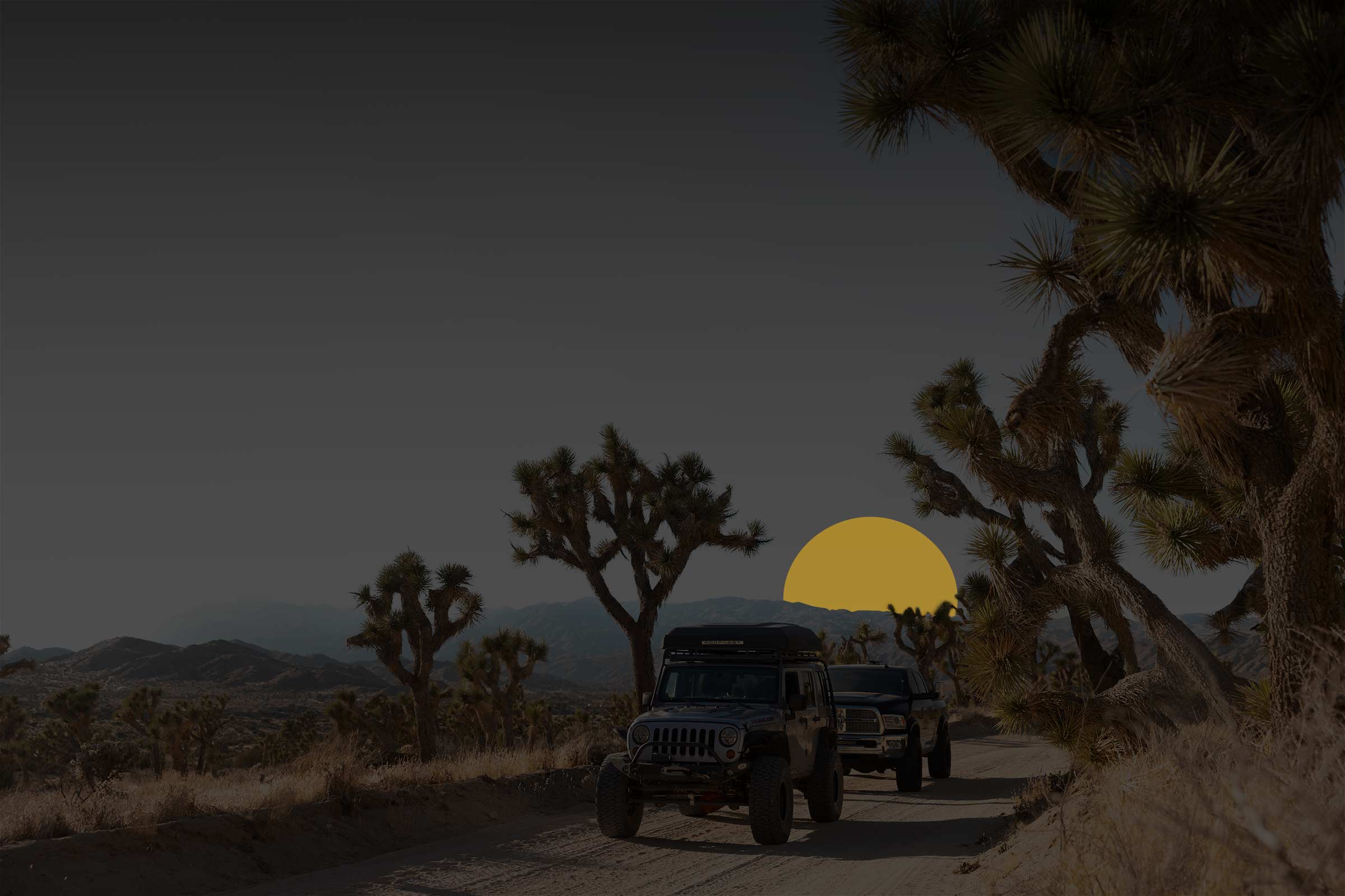This post was updated on March 1, 2023 to include up-to-date information on finding and reserving a campsite.
Camping with a Roofnest on your car's rooftop is like regular camping...but way better. You don’t have to set up a tent, it’s more comfortable, more convenient, better protected from weather, and you wake up with a heck of a panoramic view. A hard shell roof top tent automatically turns any car into a camper. That means that finding a spot where you can stay overnight with your Roofnest is really no different than looking for a camping spot for a normal tent — except with the added benefit of being able to stay in places that exclusively allow vans, campers, and RVs. When you’re looking for a place to camp in your Roofnest, you’re essentially looking for a place where you can car camp. Before you plan your next great adventure with your hard shell roof top tent, take a few minutes to check out this guide on how to find car camping spots.
How to Find Places to Camp With a Roof Top Tent
There are four main types of places where you sleep in your Roofnest overnight:
-
- Public, designated camping spots and campgrounds
- Private camping spots and campgrounds
- Public, dispersed camping on BLM land and in National Forests
- “Urban Boondocking” options such as Walmart, rest areas, and more
Let’s take a look at how to find each type of camp spot so you’ll know all your options before you hit the open road.
How to Find Public Designated Camp Spots
Public designated camp spots include campgrounds/campsites in national parks, state parks, and national forest land. Most of these sites are designed for tent campers, but they work perfectly with a rooftop tent. Some areas also have RV/camper specific sites. With a roof top tent such as the Condor Overland 2, unlike a regular tent, you can access these sites, which can be helpful during busy times. National parks and state parks are full of designated camp spots, usually for a small fee. While these spots are typically set up with regular tents in mind, there’s no reason you can’t skip the hassle of the tent and get right to relaxing in your Roofnest. Depending on the park and the campground some spots are first-come, first-serve, while others can be reserved in advance online. You can find more info and make reservations for camp spots in national parks on the National Park Service website. Just search for the park you’re interested in and go to the camping section. To find campgrounds/campsites in national forest land (and other public land management designations), visit recreation.gov and type your destination in the search bar. To find campgrounds/campsites in state parks, visit the website of the specific state park. For State Parks, each state can use different systems to handle reservations, so the best place to start will always be the official website of the park you want to visit.
How to reserve a spot
Reserve online When it comes to online reservations, planning and diligence is the name of the game. The first step is figuring out when and where you want to camp. Once you have dates and a place in mind, head to the appropriate site to make your reservations. For National Parks, check and out nps.gov or recreation.gov. For State Parks, check the official website for instructions on where to make reservations. Reserve early This is why we said to make sure you have your dates sorted first. In popular areas, like Yellowstone or the White Rim in Canyonlands, reservations often sell out the same day as they open up. For most National Parks, you can make reservations a maximum of five months ahead of time. Figure out when site reservations open and try to reserve that same day. In some of the busiest areas and camping seasons, we have seen campgrounds sellout in a few minutes. But don’t let that discourage you from trying, and if you miss your date all is not lost. Keep Checking If a campground is full, keep checking. Because the fees are so low to cancel, people will often cancel or change their reservations. There are also apps and online tools that can help you find canceled campsites. While there are paid tools available, we love using Campflare. There is an app available for iOS, but Android users can access the site in a web browser. Campflare runs a search across Recreation.gov every couple of seconds to look for site cancellations. You can set up alerts so you get a text message or notification if a site opens up in a certain campground during a set period of time. Of course, you can skip the reservations all together and just try to snag a first-come, first-serve campsite.
How to get a first-come, first-serve spot
Do your research Research the area and see how many first-come, first-serve sites there are. Doing this will give you an idea of how hard it will be to get a campsite. Additionally, call the nearest ranger station or visitor center. They likely won't know about site availability, but they will give you an idea of how busy you can expect it to be. Show up early It is in the name; these sites go to the early bird. If your research indicates that it might be hard to get a campsite, make sure you show up early. Check site tags National park and national forest campgrounds make users attach a confirmation tag to their site number (you will find these as pink slips pinned to a wood stand at the front of a campsite). These slips have dates and will indicate how long someone is staying. Talk to people Strike up a conversation with people in the campground. Other campers will often go out of their way to help you out. I've had people let me park at their campsite, so it is reserved when they leave or tell me the time they are planning on leaving. Starting conversations is especially useful if you read a slip and see people leaving that same day. Have a backup plan Make sure you always have a backup plan. Even if you follow all the tips above, there is always a chance you can’t get a spot.
Private Camp Spots
Private camp spots include your mom-and-pop campgrounds and KOAs. These are for-profit campgrounds on private land. Private camp spots are less coveted, therefore, easier to reserve. If you can't get the site you want in a national park, a private camp spot outside is not a bad second option. Being privately owned, the quality of these camp spots can vary wildly. Some will have better privacy and amenities than public camping, while others are the opposite. If you plan on staying for more than a night, make sure to do some extra research beforehand to see the quality of your intended camp spot and the accompanying facilities. First come, first serve? Almost all private camp spots are reservation-based. While you will likely be able to get a spot day off, book in advance to be safe. How to make a reservation Unlike public designated camp spots, private spots are not all managed by the same entity, making reservations more challenging. Websites like Campendium and Allstays can help you locate private campgrounds in a certain area. This means you can find a specific campground and reach out directly to make a reservation. Remember, in a pinch, RV/Camper campgrounds work with your Roofnest, so don’t be afraid of looking at RV parks if availability is a problem in the area. If you want a more streamlined option, or prefer a more unique campsite, check out hipcamp.com. In a way, Hipcamp operates like AirBnB or VRBO, but for campers, allowing private landowners to offer campsites on their own property. Hipcamp’s interface and site layout is nice to look at, and easy to use, and integrates reservations into the process, saving you a lot of time and hassle. We really appreciate that Hipcamp offers some very unique campsites. The nature of the site also means that most sites are very private, with many being just single-unit lots. They also offer a wide array of search options to help you narrow down your search to places that allow pets, or sites that are near water for example. Of course, if you really want to, you can just skip the whole process of a traditional campsite and get away into the wilderness…
Public, Dispersed Camping Areas
If you really want to get out into the wild on your next trip, dispersed camping might be for you. Dispersed camping is any camping not in designated, developed sites. That means no amenities like bathrooms, running water, or trash cans. It also means a greater level of freedom and privacy than what is available in a maintained campsite. The most widely available dispersed camping is in National Forests and BLM (Bureau of Land Management) lands. In National Forests, you can drive and park on the side of a Forest Service road and car camp there. With a little searching, you might be able to find a truly scenic spot with views more beautiful than any normal campsite. From a vista overlooking a valley and lake in the Appalachian mountains, to a rocky crag in the desert looking up at the peaks of the Rocky Mountains, BLM, and National Forest land provide some of our favorite rooftop camping experiences. Just make sure you follow the rules Before you visit a National Forest to car camp, check their website for information about any necessary permits you’ll need. This is also where you will find information on restrictions, like closed roads, off-limits areas, and fire risks. Most BLM lands are in the western US in desert climates. And like National Forests, they usually allow car camping at pullovers or on access roads. Just be sure to stay on the road shoulder or in the designated pull-off so you don’t damage the area with your vehicle (but also make sure that any other passing cars can get by).
Privacy
The best part of dispersed camping sites is that if you are willing to do a little bit of searching you can often find magical places. Many of these areas are only accessible via dirt road and are out of the way, so you can count on a fair bit of seclusion. With a Roofnest, you don’t have to worry about the ground being suitable for a tent. If you can park your car or truck, you can camp comfortably.
How to find a site?
The best way to find National Forests and BLM lands where you can car camp is to use the site Recreation.gov. Search for “National Forests in Colorado”, for example, or “BLM lands in Utah”. Another great resource to try is REI’s Camping Project on their website. It can also be helpful to use free camping resources such as ioverlander and Freecampsites.net. These are crowd-sourced directories of places other users have camped. They have information about camping spots on forest service and BLM land that have been camped at by other users. Many of the popular overlanding and off-road mapping apps like Gaia or OnX, also show land designations, so may already have access to a great repository of campsites sitting in your phone.
How do you know if it is okay to camp?
The unfortunate answer is it’s not always 100% clear. If you are on forest service or BLM land far away from recreational areas (picnic areas, trailheads, etc.) and there are no explicit signs saying otherwise, you are probably good to go. If you want to read more about the rules and regulations, you can get more info here, direct from the National Forest Service and Bureau of Land Management.
Just make sure to follow the golden rule
Remember, when you car camp in dispersed camping areas, you need to pack out what you bring in. Familiarize yourself with the Leave No Trace principles before you head out. This land needs to be treated as a privilege. Keep it clean, try to prevent or mitigate any damage or impact you make on the landscape and its inhabitants.
Alternative Places to Car Camp AKA Urban Boondocking
If you’re traveling cross country and just need to hit the hay ASAP, there are a number of options for car camping in a hard shell roof top tent that aren’t available to folks lugging around traditional tents. These include:
Walmart
Most locations allow car camping — just park out of the way in the far reaches of the lot.
Truck Stops
Look for truck stops that offer overnight spots for RVs, campers, trailers, vans, and the like. You might have to pay a fee for the spot, so just go inside and ask before you settle in for the night. Allstays.com has an epic truck stop locator, available here »
Rest Areas
The rules for overnight parking in rest areas vary from state to state.Many don’t allow overnight parking, while some do — as long as you don’t stay longer than a certain time limit. Here’s a guide to rest area car camping rules for each state »
Casinos
You may be surprised to learn that many casinos offer overnight parking for RVs, campers, and car camping. CasinoCamper.com is a good resource for finding casinos where this is allowed, but we’d suggest calling ahead to make sure you can stay in a roof top tent at such a facility. Just like the truck stop option, don’t be surprised if you need to pay a small fee for the privilege.
Find Your Next Roofnest Get-Away
With just a little bit of searching, you can find thousands of places to car camp in your Falcon 3 EVO XL or any other Roofnest all across the US. That includes on the slopes for backcountry skiing, at music festivals, and these surprising ways to use your roof top tent. But if you don’t want to do the digging yourself, let us do it for you. Our blog is always being updated with posts about the best car camping spots around the country. Be sure to check back regularly to see our top picks for campsites near you.




